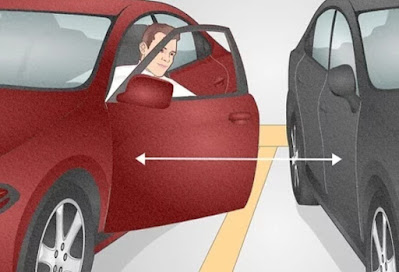Pre Driving Checks / Pre Driving Preparations
Bare minimum checks:
- Adjust seat and mirrors
- Wear seat belt
- Check for neutral gear
- Check for hand brake engagement
- Start the engine
- Check for any warning indicator
Subsequent checks in details:
Sitting position:
In the driver seat, you should have a comfortable posture to have easy access of all the vehicle controls. You should have a good view of the road around the vehicle
Sitting Posture:
- Ensure comfortable sitting posture with firm lumbar support from the seat’s back. 100 to 110 degree is suitable.
- Hands at the steering wheel, elbows should be slightly bent.
- Do not sit erect or slouch on the seat.
- Do not ride on the steering wheel.
Clothes:
- Clothes worn by the driver should be comfortable with the movement.
- Clothes should not be very loose or tight so as to hamper free movement of the hands or feet.
Shoes
- Always wear comfortable shoes while driving to avoid inconvenience and distraction.
- Never drive with high heels or wothout shoes.
Seat adjustment:
Adjust seat slider while holding the steering wheel at 12 O'clock position, stop at a position where you get nice firm lumber support.
On pushing break pedal harder you should get sunk on seat.
Head rest adjustment:
Head rest is not a resting place for your head but is a head movement restraint in the event of a collision of your car from rear. Adjust the height of the head rest so that your head and restraint lie in one straight line.
Seat belt
A car seat belt is a safety device that secures passengers, reduces injury risk during crashes, and prevents ejection. It distributes impact forces across the body and comes in types like lap belts, three-point belts, and harnesses.
Wear the seat belt across your pelvis and chest:
- Lap belt: Position it snugly across your hips, not your stomach.
- Shoulder belt: Place it across your chest and collarbone, avoiding your neck.
Tilt steering
Tilt steering is a feature that allows drivers to adjust the height of the steering wheel to make driving more comfortable
When children are there in the car
Do not wear safety belt around infant or child
Do not allow children to stand between panel and seat.
Infant seats;
Pets
Coolant level:
- Should be within upper and lower marks
- Loss of coolant may cause engine seizure
- Never open radiator cap when hot
- Should be topped up with distilled water.
Battery electrolyte
Should be within upper and lower limit.
Top up only with distilled water.
Windshield washer liquid level
Always keep it at full level.
A dirty windshield will affect your vision at night time.
Break fluid:
Break fluid level to be with minimum and maximum level. Needs to be replaced in every two years or 20000 kms which ever occurs earlier.
Engine oil
Envine oil to be maintained within upper and lower mark hole.
To be replaced every 10000 kms or one year which occurs earlier.
Around the vehicle
- Lookout for children, pet animals as they may not be visible in blind spots.
- Check for proper tyre pressure
- Resistration plate should be intact.
- Look for any fluid leakage in under chassis.
- Check for any broken or fused lamps and its cleanliness
Mirror adjustments:
Mirror Adjustments: ORVM, IRVM, and Blind Spot
1. IRVM (Interior Rearview Mirror): Adjust to see the entire rear window directly.
2. ORVM (Outer Rearview Mirrors):
Driver's Side: Lean left; adjust to barely see the car's edge and maximize road view.
Passenger's Side: Lean right; adjust similarly for maximum coverage.
3. Blind Spot: Use blind-spot mirrors or advanced systems to cover areas not visible in ORVMs.
This setup ensures optimal visibility and minimizes blind spots for safer driving.
Check following items functionally
- Gear lever
- Parking brake
- Accelerator pedal
- Break
- Clutch
Wiper blade
Check condition of wiper blades particularly during the monsoon.
Edge should not be broken or cut.
Tool kit and emergency materials
A car toolkit and emergency materials should include:
- 1. First Aid Kit - Bandages, antiseptic, pain relievers, and other basic medical supplies.
- 2. Spare Tire & Jack - For flat tire replacement.
- 3. Jumper Cables - For dead battery issues.
- 4. Flashlight - With extra batteries, for low-light situations.
- 5. Tire Pressure Gauge - To check tire inflation.
- 6. Multi-tool/Tool Kit - For small repairs.
- 7. Flares/Reflective Triangles - To signal distress.
- 8. Emergency Blanket - For warmth in case of breakdowns in cold weather.
- 9. Water and Non-Perishable Snacks - For survival in case of long waits.
- 10. Car Manual - For specific car troubleshooting.
- 11. Tow Rope - In case the car needs to be towed.
- 12. Fire Extinguisher - For fire emergencies.
Check all indicator lamps
Check all indicator if all bulbs are ok. After engine is started , no indicator should come or come in.
Mental and physical condition
Driving under the influence of alcohol, drugs, or sleeping medications, or when angry or distracted, impairs judgment, coordination, and reaction times. It’s important to drive only when sober, calm, and fully alert to ensure safety on the road.
Loose items
- There should not be any loose items on panel and around console
- There should not be any round object like bottle which can roll under pedala.


































